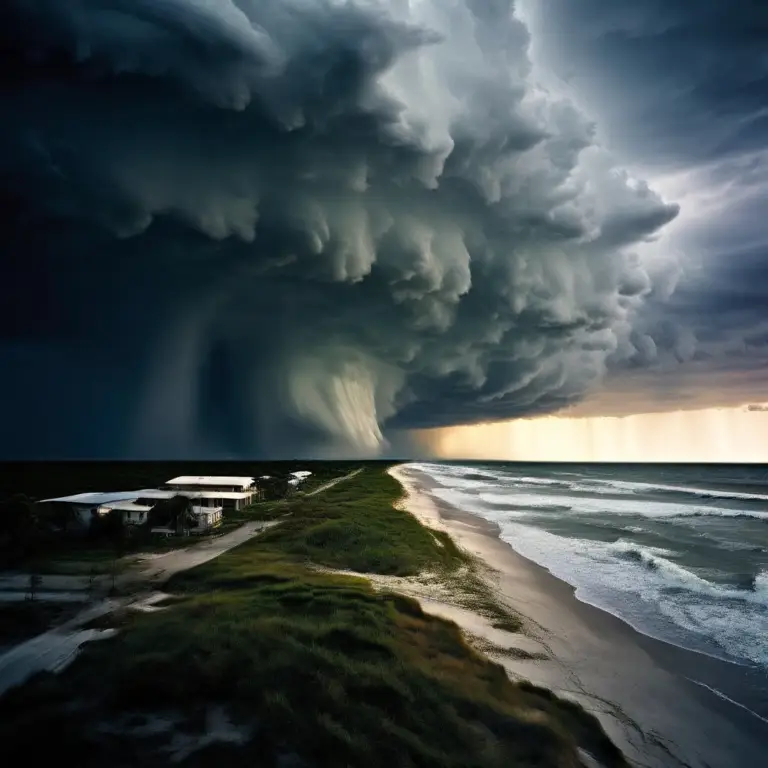Is Your Roof Ready For Hurricane Season?
Use our guide to prepare your roof for the 2024 hurricane season, it’s crucial to undertake several preparatory steps. These steps are designed to enhance the resilience of your roof against the harsh conditions typically experienced during hurricanes, such as high winds, heavy rainfall, and flying debris.

2024 Hurricane Season
The 2024 Atlantic hurricane season officially begins on June 1, 2024, and ends on November 30, 2024.
What Causes Hurricanes?
Hurricanes, also known as tropical cyclones, form under specific conditions that involve a combination of physical and atmospheric factors. The primary causes and conditions necessary for hurricane formation include:
- Warm Ocean Water: Hurricanes require warm ocean water as their primary source of energy. The water temperature must be at least 26.5 degrees Celsius (about 80 degrees Fahrenheit) over a depth of 50 meters. This warm water heats the air above it, causing the air to rise and creating a low-pressure area beneath.
- Atmospheric Moisture: As the warm, moist air rises, it cools and condenses into clouds and rain, releasing latent heat in the process. This release of heat further warms the surrounding air, causing it to rise as well, creating a cycle that can lead to the development of a storm.
- Wind Shear: Low vertical wind shear is crucial for hurricane formation. Wind shear refers to the change in wind speed or direction with height in the atmosphere. High wind shear can disrupt the organization of a developing storm, while low wind shear allows the storm to develop vertically and maintain its structure.
- Pre-existing Weather Disturbance: A hurricane often starts from a pre-existing weather disturbance, such as a tropical wave. These disturbances provide the initial low-pressure area and thunderstorm activity necessary for the storm to begin organizing and intensifying.
- Coriolis Effect: The Coriolis effect, resulting from the Earth’s rotation, provides the necessary spin for the storm. This effect is minimal at the equator and increases toward the poles, which is why hurricanes typically form at least 5 degrees latitude away from the equator.
- High Humidity: High relative humidity from the surface to the mid-levels of the atmosphere helps to fuel the storm by preventing the evaporation of cloud droplets. Dry air, on the other hand, can weaken a developing storm.
- Converging Winds: At the surface, winds converging towards the low-pressure area can force more air upwards, enhancing the storm’s development by bringing in additional moisture and warmth.
These conditions collectively contribute to the formation and intensification of hurricanes. Once formed, hurricanes draw their energy from the warm ocean waters, maintaining their strength as long as they remain over warm water and conditions remain favorable.
2024 Hurricane Forecast For The Guld Coast
 The 2024 hurricane forecast for the Gulf Coast of the United States indicates a significantly heightened risk of hurricane activity compared to historical averages. Here are the key points from the forecasts:
The 2024 hurricane forecast for the Gulf Coast of the United States indicates a significantly heightened risk of hurricane activity compared to historical averages. Here are the key points from the forecasts:
- Increased Probability of Landfall: The Gulf Coast, which includes states like Texas, Louisiana, Mississippi, and Alabama, has a predicted 42% chance of experiencing a hurricane landfall. This is substantially higher than the historical average landfall probability of 27%.
- High Activity Forecast: Various meteorological organizations predict an active hurricane season for 2024. AccuWeather has raised concerns about an “explosive” hurricane season, with a significant number of storms potentially affecting the Gulf Coast. They predict as many as 25 named storms, with upwards of 12 hurricanes, and as many as seven strong hurricanes.
- Warm Ocean Temperatures and La Niña Conditions: The forecasted high activity is partly due to unusually warm Gulf waters and the expected presence of La Niña conditions. La Niña typically reduces vertical wind shear in the Atlantic, which is favorable for hurricane formation and strengthening.
- Concerns for Texas and Louisiana: Specific concerns have been raised for the Texas and Louisiana coastlines, where the combination of warm Gulf waters and favorable atmospheric conditions could lead to increased hurricane formation and intensification.
- Preparation and Impact: Given the forecasts, residents along the Gulf Coast are advised to prepare for a potentially above-average hurricane season. This includes understanding evacuation routes, having hurricane supplies ready, and staying informed through updates from meteorological agencies.
Overall, the 2024 hurricane season is expected to be particularly challenging for the Gulf Coast, with meteorologists advising heightened preparedness due to the increased likelihood of significant hurricane impacts.
Hurricane Safety The Texas Gulf Coast
Hurricane safety near the Gulf Coast involves a comprehensive approach to preparedness, response, and recovery. Here are key measures based on the provided sources:
Before a Hurricane
- Stay Informed: Follow reliable sources for weather updates, such as the National Weather Service, local meteorologists, and emergency management agencies.
- Secure Your Property: Use permanent storm shutters or board up windows with marine plywood. Secure outdoor objects and trim trees and shrubs.
- Prepare an Emergency Kit: Include supplies recommended on FEMA’s hurricane preparedness checklist, such as water, non-perishable food, medications, flashlights, batteries, and important documents.
- Know Your Evacuation Zone: Familiarize yourself with your evacuation zone and routes. Have a plan for where you will go if ordered to evacuate.
- Prepare for Storm Surge: Understand the risk of storm surge, which can cause significant flooding and is often the most dangerous aspect of a hurricane.
During a Hurricane
- Evacuate if Ordered: Never ignore an evacuation order. Follow designated evacuation routes and expect heavy traffic.
- Shelter Safely: If not evacuating, stay indoors away from windows and doors. Take refuge in a small, interior, windowless room on the lowest level not likely to flood.
- Monitor Updates: Keep a battery-powered or hand-crank radio to listen to emergency broadcasts if the power goes out.
After a Hurricane
- Stay Informed: Continue to follow official sources for updates on when it is safe to return home and for information on recovery resources.
- Inspect Your Property: Carefully inspect your property for damage. Avoid downed power lines and standing water.
- Document Damage: Take photos of any damage for insurance claims. Begin cleanup and repairs only when it is safe to do so.
General Preparedness Tips
- Insurance: Review your insurance policies to ensure they cover hurricane-related damages, including flooding.
- Community Resources: Know the locations of shelters and resources like food banks in case of displacement.
- Special Needs: Register in advance with local emergency management if you require special assistance during evacuations.
By taking these steps, residents near the Gulf Coast can significantly improve their safety and resilience in the face of hurricanes. Preparation is key to minimizing the impact of these powerful storms.
